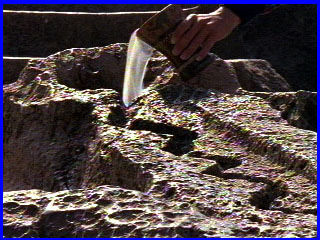 |
 |
 |
 The Sacrificial Ceremony
The Sacrificial Ceremonyby Liesl Clark The Lost Empire | The Sacrificial Ceremony | High Altitude Archaeology | Burial Artefacts The Tanta Carhua Story "Beautiful beyond exaggeration," is how one Spanish chronicler described Tanta Carhua. Carhua was a ten-year old Inca child whose father offered her to the Inca Emperor as a Capacocha sacrifice. She was taken by priests to Cuzco where she met the Inca Emperor, and on her return journey to the mountain where she would be sacrificed the procession passed through her home village. According to the legends, Tanta Carhua told the village: "You can finish with me now because I could not be more honoured than by the feasts which they celebrated for me in Cuzco." Tanta Carhua was then taken to a high Andean mountain, placed in a shaft-tomb and walled in alive. Chicha, a maize alcohol, was fed to her both before and after her death. And in death, this beautiful ten-year old child became a goddess, speaking to her people as an oracle from the mountain, which was reconsecrated in her name. Capacocha Very little is known about Capacocha, the sacred Inca ceremony of human sacrifice, but with each new archaeological discovery of a sacrificial mummy, more is revealed. The earliest and only known written accounts of the ritual are chronicles written by Spanish conquistador historians. From the chronicles and from each new discovery of a mummy, the pieces of this great puzzle are put together to reveal an intricate and extremely important ritual that involved sacrifice of children, worship of mountains as gods, and elaborate burial procedures. Sacrifices were often made during or after a portentous event: an earthquake, an epidemic, a drought, or after the death of an Inca Emperor. According to archaeologist Juan Schobinger, "Inca sacrifices often involved the child of a chief. The sacrificed child was thought of as a deity, ensuring a tie between the chief and the Inca emperor, who was considered a descendant of the Sun god. The sacrifice also bestowed an elevated status on the chief's family and descendants." The honour of sacrifice was bestowed not only on the family, but was forever immortalized in the child. It is believed that the sacrificial children had to be perfect, without so much as a blemish or irregularity in their physical beauty. After a child was chosen or offered to the emperor, a procession would begin from the child's home village to Cuzco, the crown seat of the Inca empire. Priests, family members, and chiefs would accompany the child on this great journey to meet the emperor. Huge ceremonial feasts would take place in Cuzco where the child would meet the emperor and forever bring credit to the family in this important event. Priests would then lead the grand procession to the designated high mountain. Often, a base camp would be established lower on the mountain, at a more comfortable elevation. Here, llamas (which carried up 80-pound loads of soil, grass, and often stones for the camp structures from the villages below) would be coralled, and permanent stone structures would be built to offer shelter to the priests and the child. Continue Expedition '96 | Dispatches | Mummies | Lost Worlds | Mail Resources | Site Map | Ice Mummies of the Inca Home | BBC Horizon Editor's Picks | Previous Sites | Join Us/E-mail | TV/Web Schedule About NOVA | Teachers | Site Map | Shop | Jobs | Search | To print PBS Online | NOVA Online | WGBH © | Updated November 2000 |